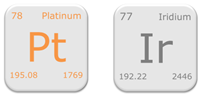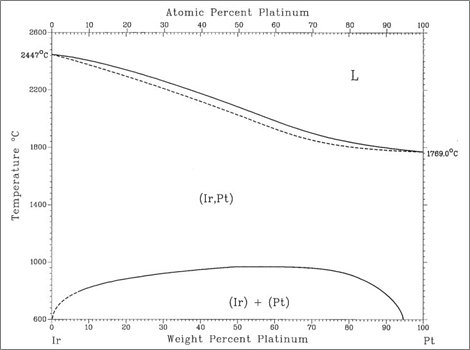 Even though the platinum-iridium alloys are not used in the same quantities as the platinum-rhodium alloys, they play an important role in very many applications. Small additions of iridium (typically 0.3 or 1%) improve the microstructural stability of the platinum at elevated temperatures, without significantly affecting the mechanical strength and the forming characteristics. Typical alloy compositions are platinum with 10, 20 or 30% iridium.
Even though the platinum-iridium alloys are not used in the same quantities as the platinum-rhodium alloys, they play an important role in very many applications. Small additions of iridium (typically 0.3 or 1%) improve the microstructural stability of the platinum at elevated temperatures, without significantly affecting the mechanical strength and the forming characteristics. Typical alloy compositions are platinum with 10, 20 or 30% iridium.
As the range of phase separation between iridium and platinum extends to a temperature of about 1,000°C, exposure of alloys with 20 or 30% iridium to temperatures around 800-900°C can lead to the precipitation of iridium and thus cause embrittlement of the material.
With increasing iridium contents, the strength increases more rapidly than with the platinum-rhodium alloys. However, a disadvantage in the application of the platinum-iridium alloys is their significantly poorer oxidation resistance in comparison with platinum and the platinum-rhodium alloys because the iridium content forms an oxide that evaporates more rapidly than it forms at temperatures >1,000°C (the surface remains metallically clean). Platinum-iridium alloys are even more corrosion resistant than platinum in aqueous media and many corrosive media and demonstrate outstanding tissue compatibility with the human body.

Phase diagram of the alloy system platinum-iridium
Source: "Binary Alloy Phase Diagrams plus Updates", ASM International 1996
.